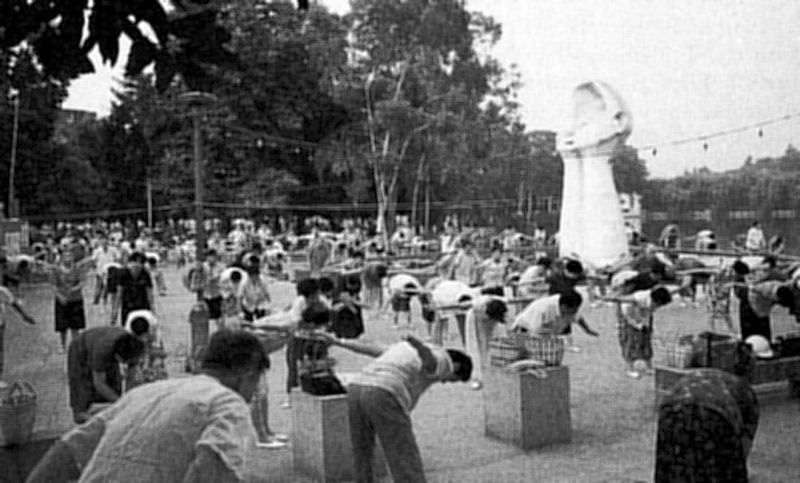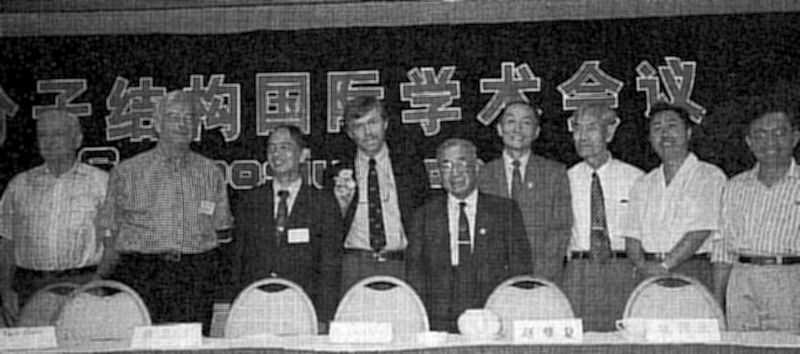


IUCr Congress
Small Molecule Symposium
 Everything at the spectacular opening banquet of the Fuzhou Satellite Symposium was as exquisitely presented as the artistically carved melon. Everything tasted even better than it looked. Seated from left B. Sharma (USA), H.-B. Burgi (Switzerland), D. Eggleston (USA), G. Chapuis (France); standing from left, unidentified, Han Fuson (USA), G. Diaz Delgado and M. Delgado (Venezuela), unidentified.
Everything at the spectacular opening banquet of the Fuzhou Satellite Symposium was as exquisitely presented as the artistically carved melon. Everything tasted even better than it looked. Seated from left B. Sharma (USA), H.-B. Burgi (Switzerland), D. Eggleston (USA), G. Chapuis (France); standing from left, unidentified, Han Fuson (USA), G. Diaz Delgado and M. Delgado (Venezuela), unidentified.
The prime themes of the small molecule symposium in Fuzhou, Aug. 31-Sept. 3, were: (1) systematic analysis of molecular geometry, conformation, and hydrogen bonding; (2) molecular interaction and recognition in crystals; (3) phase relations and transformation in small moiety systems; and (4) properties and design of new materials. E. Benedetti (Italy) methodically illustrated how, at least in the case of some unusual amino acid residues, the peptide controls conformation. He also illustrated that the distribution of peptide conformations in small single crystal studies agrees with the distribution in proteins. D. Eggleston (USA) discussed peptide conformation and correlation with function from the perspective of the pharmaceutical industry.
 6 AM morning wake up call in the park beside the conference hotel in Fuzhou. Looking for contact lenses or preparing for flight?
6 AM morning wake up call in the park beside the conference hotel in Fuzhou. Looking for contact lenses or preparing for flight?
Hydrogen bonding was examined from a variety of perspectives. G. Gilli presented a careful analysis of hydrogen bond geometry drawn from the Cambridge Structural Database (CSD). In his poster, A. E. Masunov (Russia) illustrated how hydrogen bonds dominate patterns in molecular packing. Dr. Tsai (PRC) repeatedly drew attention to the question of how hydride ions travel over long distances in macromolecular systems and suggested that hydrogen bond networks might facilitate this transfer. A Katrusiak (Poland) showed how a shift in the position of the hydrogen atom in a hydrogen bond has a significant influence on intramolecular association with important consequences on the physical and chemical properties of a system. Among Katrusiak's examples were illustrations of hydrogen bond geometry shifts associated with phase changes and color changes in crystals.
 Closing ceremony at the Fuzhou Satellite Symposium (from left) F. Herbstein (Israel), T. Hahn (Germany), J.-L. Huang (PRC), V. Bear (USA), W. L. Duax (USA), J. X. Lu (PRC), K. W. Quian (PRC), K. Tsai (PRC), B. C. Lin (PRC), and Z. M. Chen (PRC).
Closing ceremony at the Fuzhou Satellite Symposium (from left) F. Herbstein (Israel), T. Hahn (Germany), J.-L. Huang (PRC), V. Bear (USA), W. L. Duax (USA), J. X. Lu (PRC), K. W. Quian (PRC), K. Tsai (PRC), B. C. Lin (PRC), and Z. M. Chen (PRC).
One of the highlights of the meeting occurred when Mr. M.-X. Chen (PRC) gave a brief account of his poster presentation concerning a thermolumenescent effect and its potential practical applications. M. Wang (PRC) described her efforts to correlate structures of Europium Complexes with luminescence spectra.
C. Pascard (France) presented a splendid overview of molecular recognition in crystal structures, including three different mechanisms by which molecular recognition may be achieved either by full incorporation or external association. Pascard's emphasis was on rarely studied anion recognition compounds. Macromolecular ligands for the complexation of rare earth metals was the subject of several posters including those of J. G. Mao and Z. G. Lin (PRC). J. Lipkowski (Poland) described a particularly versatile 30 crown-6-macrocycle that had a variety of stable conformations and could complex cations, anions, and neutral compounds offering fertile ground for futher modification to create highly selective binding. Chirality was the theme of X. T. Wu's (PRC) talk, although in this case it was applied to Transition Metal Complexes.
The splendid series of talks by A. Katrusiak (Poland), T. Hahn (Germany), F. Herbstein (Israel), G. Chapuis (France), and J. L. Baudour (France) described theory and observations of phase transitions, order-disorder transitions, and modulated structures. T. Hahn laid the ground work with an exposition of different types of phase transition, provided complex examples from inorganic chemistry, and showed wonderful transparencies of single crystals incorporating two or more phases. G. Chapuis also provided color transparencies illustrating modulated structure transformation. The speakers in the session debated extensively about the proper use and possible misuse of Landau theory. F. Herbstein illustrated how spontaneous strain, as a function of temperature measurements, and the intensities of superlattice intensities obeyed Landau theory but that excess specific heat generated in a second order disorder to order transition did not.
J. Huang, X. Wu, Y. Xu, and M. Hong (PRC) described systematic analysis of metal cluster compounds, including one-dimensional, two-dimensional, and three-dimensional lattices having a great many potential practical applications. D. Tsai (PRC) demonstrated a link between these metal cluster studies and biological applications in protein structures having metal cluster centers such as nitrogenases. M. Delgado (Venezuela) presented a systematic analysis of ternary and quaternary semiconductor compounds. Prof. Liu (PRC) brought organics, metals, and biology together with his copper carbonylate compounds that have plant growth activity.
One of the disadvantages of the Beijing meeting was that people engaged in organic crystallography, materials crystallography and biological crystallography did not take the time to learn about each other's work. The Fuzhou Small Molecule symposium provided the opportunity to listen to and learn from one another. J. Huang and S. X. Liu organized a meeting at which the food, the accommodations, the science, and the experiences were rich, rewarding, and memorable.
W. L. Duax

